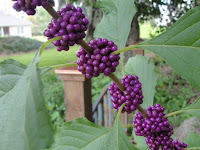The last and final step in turning your garden into a wildlife habitat is to garden sustainably. That's a big term for practicing natural garden techniques in your yard. Wildlife are sensitive to chemicals so it makes sense to incorporate this last element into the garden whenever and wherever possible.
The Fifth Element necessary to attract wildlife is to practice sustainable gardening techniques.
Tips for creating a more sustainable landscape:
* Enriching your soil with compost prior to planting will help plants thrive and reduce the chances of insect invasions.
* Plant Florida-friendly and native plants so that you will experience less disease and pest problems.
* Use the least toxic methods for controlling pests such as hand-picking, BT for caterpillars, horticulture oil for scale, baking soda to eliminate crabgrass, horticulture soap for most insects.
* Mulch (pine bark, hay straw or pine needles - no cypress mulch, please) to reduce weeds.
* Use less fertilizer or eliminate large portions of turf grass.
* Fertilize plants with natural products such as compost, compost tea, fish emulsion or manure.
Wildlife Friendly Tip
Mix up a batch of homemade horticulture soap which is very effective in eliminating a large number of pests in the garden. Mix together 2 Tablespoons of dishwashing liquid into one gallon of water. Pour into a spray bottle and you've got an easy remedy to combat mealybugs, aphids, soft scale, thrips and mites.
Test out your product on a small portion of a plant before spraying the entire plant as some plants may be sensitive to the soap. Also, do not spray when temperatures are 90 degrees or above. I like to spray my plants in late afternoon and then give them a rinse the next morning.
~ ~ ~ ~ ~ ~ ~ ~ ~ ~ ~ ~ ~ ~ ~ ~ ~ ~ ~ ~ ~ ~ ~ ~ ~ ~ ~ ~ ~ ~ ~ ~ ~ ~ ~ ~
Now that you've turned your yard into a "Florida-friendly Wildlife Habitat" why not take the next step and get it certified by the National Wildlife Federation (NWF). Florida gardens are only 2nd to California in the number of gardens certified by the NWF. So, let's all get on board and make Florida #1 in the country!
As a recap, the following are the 5 steps required by the National Wildlife Federation for creating a "certified wildlife habitat:"
•Food Sources - For example: Native plants, seeds, fruits, nuts, berries, nectar
•Water Sources - For example: Birdbath, pond, water garden, stream
•Places for Cover - For example: Thicket, rockpile, birdhouse
•Places to Raise Young - For example: Dense shrubs, vegetation, nesting box, pond
•Sustainable Gardening - For example: Mulch, compost, rain garden, chemical-free fertilizer
When you certify your garden, you'll receive all these NWF benefits:
•A personalized certificate that recognizes your NWF Certified Wildlife Habitat™.
•A free NWF membership which includes a full year's subscription to the award-winning National Wildlife® magazine and 10% off all NWF catalog purchases.
•A free subscription to the quarterly e-newsletter, Habitats, full of insightful tips and information on gardening and attracting wildlife year after year.
•Your name listed in NWF's National registry of certified habitats...to recognize all you've done for wildlife.
And, once you complete your application, you'll be eligible to purchase the "wildly" popular Certified Wildlife Habitat™ yard sign (above) that shows your commitment to conserving wildlife.
Start your certification application here >> NWF Certified Wildlife Habitat
As you create your own wildlife friendly garden I would love to hear about your experiences, suggestions, tips and questions involving your transformation. You can reach me at: cenflagardener at gmail.com. Congratulations and good luck in transforming your yard into a wildlife habitat



.JPG)














